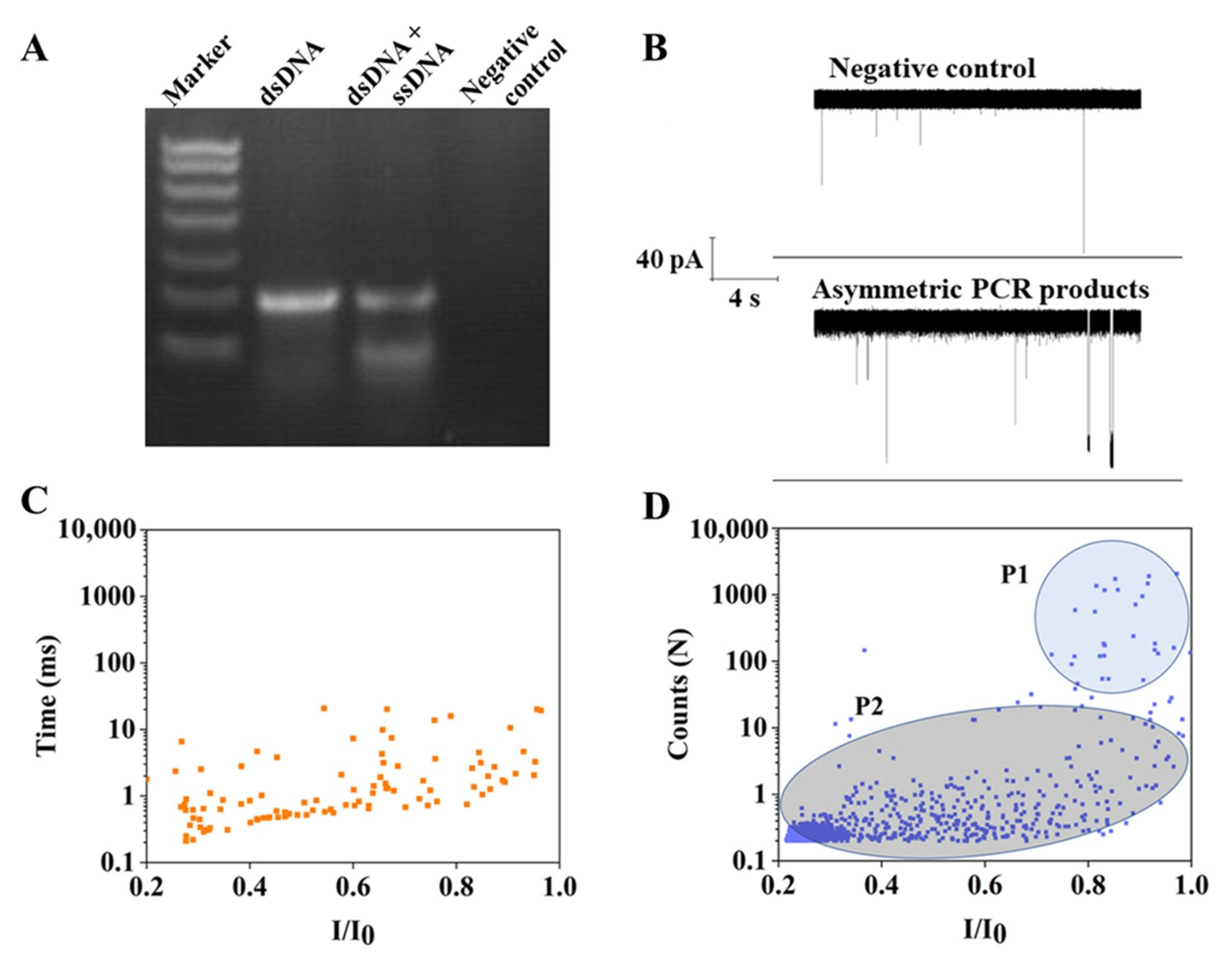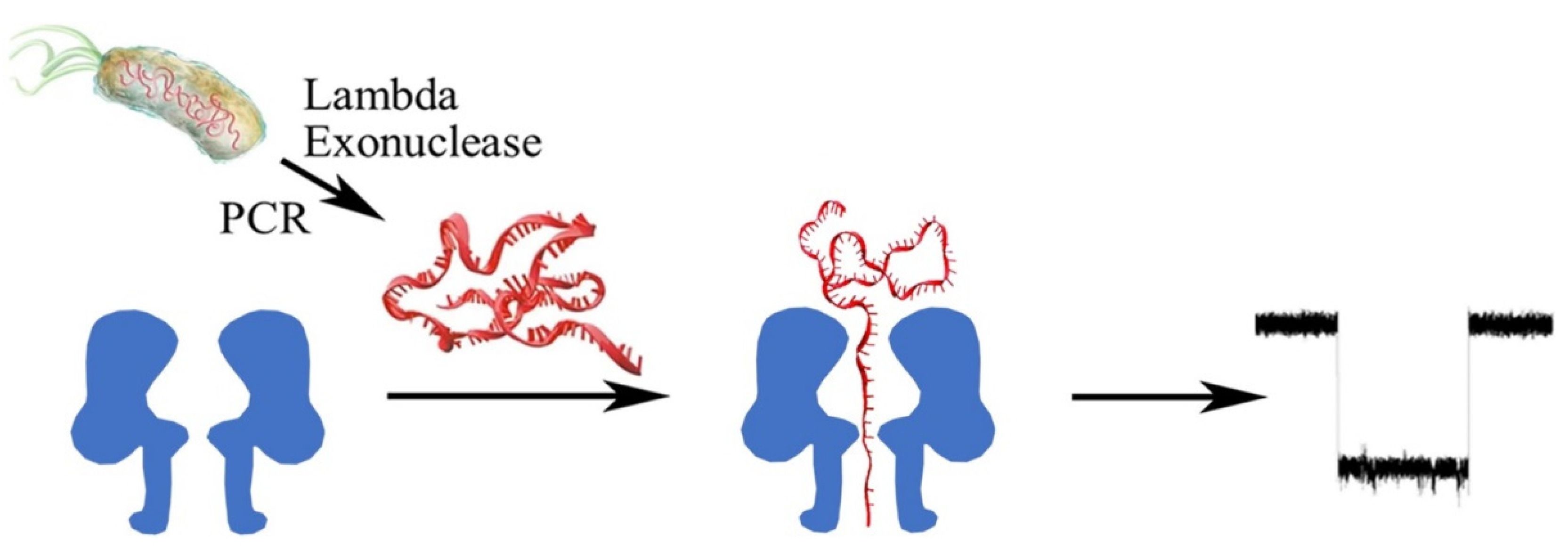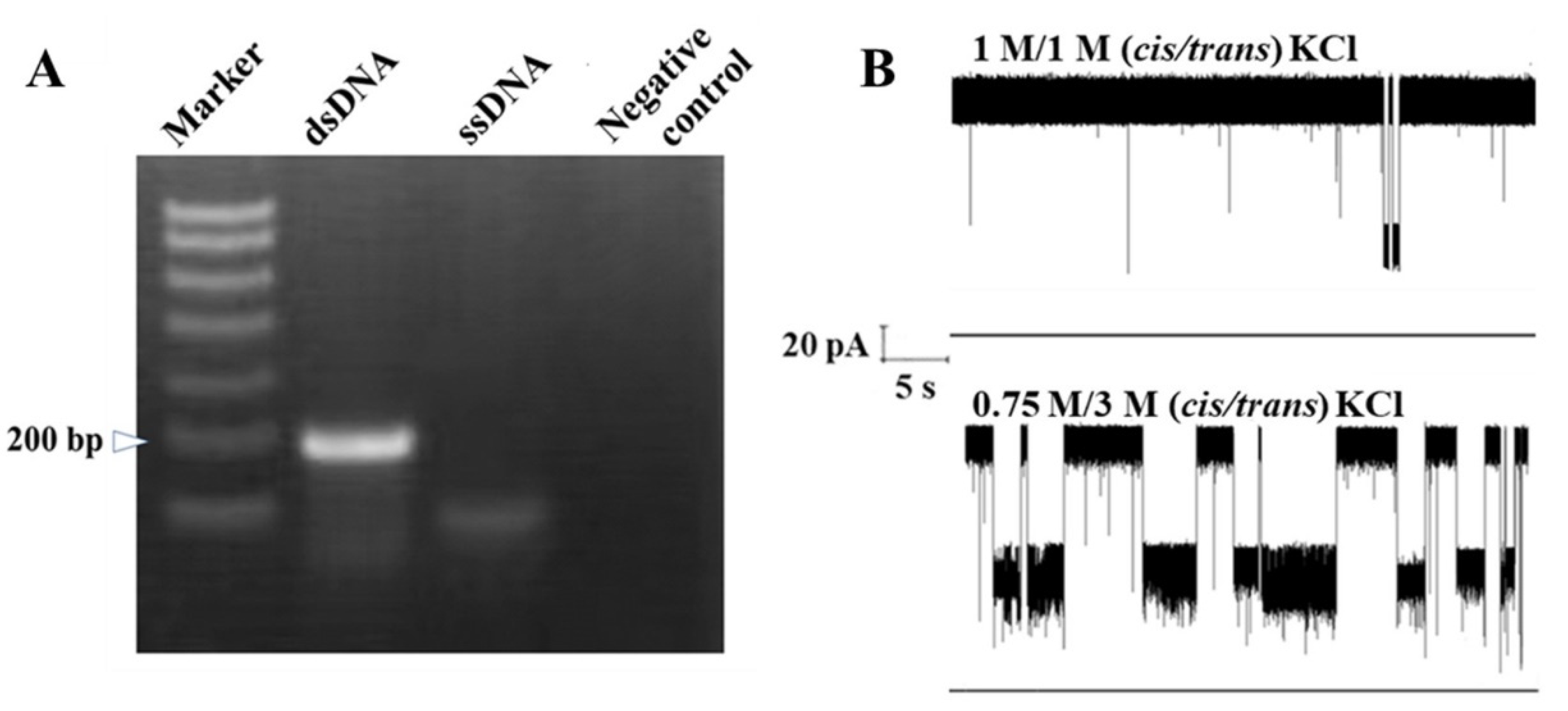Detection of Tobacco Bacterial Wilt Caused by Ralstonia solanacearum by Combining Polymerase Chain Reaction with an α-Hemolysin Nanopore
Abstract
:1. Introduction
2. Experimental Section
2.1. Chemicals
2.2. Apparatus
2.3. DNA Extraction and PCR
2.4. Digestion by Lambda Exonuclease
2.5. Nanopore Electrical Recording and Data Analysis
3. Results
3.1. Feasibility of Detecting R. solanacearum by Combining Asymmetric PCR with an α-HL Nanopore
3.2. Enhancing the Performance of the PCR–α-HL Strategy Using Lambda Exonuclease and Gradient Salt Concentration
3.3. Application of This Method to Tobacco Fields
4. Conclusions
Supplementary Materials
Author Contributions
Funding
Institutional Review Board Statement
Informed Consent Statement
Data Availability Statement
Conflicts of Interest
References
- Mullis, K.B.; Saiki, R.K.; Scharf, S.; Faloona, F.; Horn, G.T.; Erlich, H.A.; Arnheim, N. Enzymatic amplification of β-globin genomic sequences and restriction site analysis for diagnosis of sickle cell anemia. Science 1985, 230, 1350–1354. [Google Scholar]
- Wang, Y.; Li, B.; Zhang, N.; Xi, D.; Liu, J.; Zhou, H. Viral cdna-based extension for highly sensitive fluorescence detection of DNA methyltransferase activity. Sens. Actuators B Chem. 2018, 255, 3488–3494. [Google Scholar] [CrossRef]
- Wu, Y.D.; Xu, M.J.; Wang, Q.Q.; Zhou, C.X.; Wang, M.; Zhu, X.Q.; Zhou, D.H. Recombinase polymerase amplification (rpa) combined with lateral flow (lf) strip for detection of toxoplasma gondii in the environment. Vet. Parasitol. 2017, 243, 199–203. [Google Scholar] [CrossRef] [PubMed]
- Huang, Y.; Chen, W.; Chung, J.; Yin, J.; Yoon, J. Recent progress in fluorescent probes for bacteria. Chem. Soc. Rev. 2021, 50, 7725–7744. [Google Scholar] [CrossRef]
- Rabber, L.; Ernest, T.E.; Gelkop, Y.M.; Lahav, M.C.; Douvdevani, A.; Nahum, A. Fast fluorometric method for measuring circulating cell-free DNA could aid the diagnosis of febrile children. Acta Paediatr. 2021, 110, 1577–1578. [Google Scholar] [CrossRef]
- Chen, B.-B.; Liu, M.-L.; Gao, Y.-T.; Chang, S.; Qian, R.-C.; Li, D.-W. Design and applications of carbon dots-based ratiometric fluorescent probes: A review. Nano Res. 2022, 16, 1064–1083. [Google Scholar] [CrossRef]
- Wang, C.; Chen, X.; Wu, Y.; Li, H.; Wang, Y.; Pan, X.; Tang, T.; Liu, Z.; Li, X. Lateral flow strip for visual detection of k-ras mutations based on allele-specific pcr. Biotechnol. Lett. 2016, 38, 1709–1714. [Google Scholar] [CrossRef]
- Gong, X.; Cai, J.; Zhang, B.; Zhao, Q.; Piao, J.; Peng, W.; Gao, W.; Zhou, D.; Zhao, M.; Chang, J. A review for fluorescent lateral flow immunochromatographic strip. J. Mater. Chem. B 2017, 5, 5079–5091. [Google Scholar] [CrossRef]
- Laszlo, A.H.; Derrington, I.M.; Ross, B.C.; Brinkerhoff, H.; Adey, A.; Nova, I.C.; Craig, J.M.; Langford, K.W.; Samson, J.M.; Daza, R.; et al. Decoding long nanopore sequencing reads of natural DNA. Nat. Biotechnol. 2014, 32, 829–833. [Google Scholar] [CrossRef] [Green Version]
- Wang, Y.; Zhang, Y.; Chen, X.; Guan, X.; Wang, L. Analysis with biological nanopore: On-pore, off-pore strategies and application in biological fluids. Talanta 2021, 223, 121684. [Google Scholar] [CrossRef]
- Tang, W.; Fried, J.P.; Tilley, R.D.; Gooding, J.J. Understanding and modelling the magnitude of the change in current of nanopore sensors. Chem. Soc. Rev. 2022, 51, 5757–5776. [Google Scholar] [CrossRef] [PubMed]
- Wen, S.; Zeng, T.; Liu, L.; Zhao, K.; Zhao, Y.; Liu, X.; Wu, H.C. Highly sensitive and selective DNA-based detection of mercury(ii) with α-hemolysin nanopore. J. Am. Chem. Soc. 2011, 133, 18312–18317. [Google Scholar] [CrossRef] [PubMed]
- Wanunu, M.; Dadosh, T.; Ray, V.; Jin, J.; Mcreynolds, L.; Drndic, M. Rapid electronic detection of probe-specific micrornas using thin nanopore sensors. Nat. Nanotechnol. 2010, 5, 807–814. [Google Scholar] [CrossRef] [PubMed]
- Huo, M.Z.; Li, M.Y.; Ying, Y.L.; Long, Y.T. Is the volume exclusion model practicable for nanopore protein sequencing? Anal. Chem. 2021, 93, 11364–11369. [Google Scholar] [CrossRef]
- Zhou, S.; Wang, H.; Chen, X.; Wang, Y.; Zhou, D.; Liang, L.; Wang, L.; Wang, D.; Guan, X. Single-molecule study on the interactions between cyclic nonribosomal peptides and protein nanopore. ACS Appl. Bio. Mater. 2020, 3, 554–560. [Google Scholar] [CrossRef] [PubMed] [Green Version]
- Ramsay, W.J.; Bayley, H. Single-molecule determination of the isomers of d-glucose and d-fructose that bind to boronic acids. Angew. Chem. Int. Ed. Engl. 2018, 57, 2841–2845. [Google Scholar] [CrossRef]
- Orit, B.; Gu, L.-Q.; Zhou, L.; Lu, X.; Cheley, S.; Bayley, H. Simultaneous stochastic sensing of divalent metal ions. Nat. Biotechnol. 2000, 18, 1005–1007. [Google Scholar]
- Mayer, S.F.; Cao, C.; Dal Peraro, M. Biological nanopores for single-molecule sensing. IScience 2022, 25, 104145. [Google Scholar] [CrossRef]
- Zhou, S.; Wang, L.; Chen, X.; Guan, X. Label-free nanopore single-molecule measurement of trypsin activity. ACS Sens. 2016, 1, 607–613. [Google Scholar] [CrossRef] [Green Version]
- Kasianowicz, J.J.; Brandin, E.; Branton, D.; Deamer, D.W. Characterization of individual polynucleotide molecules using a membrane channel. Proc. Natl. Acad. Sci. USA 1996, 93, 13770–13773. [Google Scholar] [CrossRef] [Green Version]
- Ashkenasy, N.; Sanchez-Quesada, J.; Bayley, H.; Ghadiri, M.R. Recognizing a single base in an individual DNA strand: A step toward DNA sequencing in nanopores. Angew. Chem. Int. Ed. Engl. 2005, 44, 1401–1404. [Google Scholar] [CrossRef] [PubMed] [Green Version]
- Wang, Y.; Zhao, Y.; Bollas, A.; Wang, Y.; Au, K.F. Nanopore sequencing technology, bioinformatics and applications. Nat. Biotechnol. 2021, 39, 1348–1365. [Google Scholar] [CrossRef] [PubMed]
- King, S.; Briggs, K.; Slinger, R.; Tabard-Cossa, V. Screening for group a streptococcal disease via solid-state nanopore detection of pcr amplicons. ACS Sens. 2022, 7, 207–214. [Google Scholar] [CrossRef]
- Genin, S. Molecular traits controlling host range and adaptation to plants in ralstonia solanacearum. N. Phytol. 2010, 187, 920–928. [Google Scholar] [CrossRef]
- Bittner, R.J.; Arellano, C.; Mila, A.L. Effect of temperature and resistance of tobacco cultivars to the progression of bacterial wilt, caused by ralstonia solanacearum. Plant Soil 2016, 408, 299–310. [Google Scholar] [CrossRef]
- Haugland, M.M.; Borsley, S.; Cairns-Gibson, D.F.; Elmi, A.; Cockroft, S.L. Synthetically diversified protein nanopores: Resolving click reaction mechanisms. ACS Nano 2019, 13, 4101–4110. [Google Scholar] [CrossRef] [PubMed] [Green Version]
- Liu, Y.; Zhang, S.; Wang, Y.; Wang, L.; Cao, Z.; Sun, W.; Fan, P.; Zhang, P.; Chen, H.Y.; Huang, S. Nanopore identification of alditol epimers and their application in rapid analysis of alditol-containing drinks and healthcare products. J. Am. Chem. Soc. 2022, 144, 13717–13728. [Google Scholar] [CrossRef]
- Jeong, K.B.; Luo, K.; Lee, H.; Lim, M.C.; Yu, J.; Choi, S.J.; Kim, K.B.; Jeon, T.J.; Kim, Y.R. Alpha-hederin nanopore for single nucleotide discrimination. ACS Nano 2019, 13, 1719–1727. [Google Scholar] [CrossRef]
- Rotem, D.; Jayasinghe, L.; Salichou, M.; Bayley, H. Protein detection by nanopores equipped with aptamers. J. Am. Chem. Soc. 2012, 134, 2781–2787. [Google Scholar] [CrossRef]
- Hu, L.; Mu, W.; Guo, J.; Xue, C.; Feng, X.; Xi, J.; Zhang, Z.; Zhang, Y.; Li, Y.; Zhou, H.; et al. Locked nucleic acid-enhanced quantitative real-time pcr detection of ralstonia solanacearum in tobacco planting soil. Tob. Sci. Technol. 2017, 50, 14–21. [Google Scholar]
- Cao, C.; Long, Y.T. Biological nanopores: Confined spaces for electrochemical single-molecule analysis. Acc. Chem. Res. 2018, 51, 331–341. [Google Scholar] [CrossRef] [PubMed]
- Dragomir, I.S.; Bucataru, I.C.; Schiopu, I.; Luchian, T. Unzipping mechanism of free and polyarginine-conjugated DNA-pna duplexes, preconfined inside the α-hemolysin nanopore. Anal. Chem. 2020, 92, 7800–7807. [Google Scholar] [CrossRef] [PubMed]
- Tan, C.S.; Riedl, J.; Fleming, A.M.; Burrows, C.J.; White, H.S. Kinetics of t3-DNA ligase-catalyzed phosphodiester bond formation measured using the α-hemolysin nanopore. ACS Nano 2016, 10, 11127–11135. [Google Scholar] [CrossRef] [PubMed]
- Xi, D.; Li, Z.; Liu, L.; Ai, S.; Zhang, S. Ultrasensitive detection of cancer cells combining enzymatic signal amplification with an aerolysin nanopore. Anal. Chem. 2018, 90, 1029–1034. [Google Scholar] [CrossRef] [PubMed]





| Sample | Sequencing | This Method | ||
|---|---|---|---|---|
| Positive | Negative | Positive | Negative | |
| 1 | 1 | 0 | 1 | 0 |
| 5 | 4 | 1 | 4 | 1 |
Disclaimer/Publisher’s Note: The statements, opinions and data contained in all publications are solely those of the individual author(s) and contributor(s) and not of MDPI and/or the editor(s). MDPI and/or the editor(s) disclaim responsibility for any injury to people or property resulting from any ideas, methods, instructions or products referred to in the content. |
© 2023 by the authors. Licensee MDPI, Basel, Switzerland. This article is an open access article distributed under the terms and conditions of the Creative Commons Attribution (CC BY) license (https://creativecommons.org/licenses/by/4.0/).
Share and Cite
Wang, Y.; Li, Y.; Zhou, X.; Zhang, W.; Zhang, S.; Xi, D. Detection of Tobacco Bacterial Wilt Caused by Ralstonia solanacearum by Combining Polymerase Chain Reaction with an α-Hemolysin Nanopore. Nanomaterials 2023, 13, 332. https://doi.org/10.3390/nano13020332
Wang Y, Li Y, Zhou X, Zhang W, Zhang S, Xi D. Detection of Tobacco Bacterial Wilt Caused by Ralstonia solanacearum by Combining Polymerase Chain Reaction with an α-Hemolysin Nanopore. Nanomaterials. 2023; 13(2):332. https://doi.org/10.3390/nano13020332
Chicago/Turabian StyleWang, Ying, Yusen Li, Xin Zhou, Wenna Zhang, Shusheng Zhang, and Dongmei Xi. 2023. "Detection of Tobacco Bacterial Wilt Caused by Ralstonia solanacearum by Combining Polymerase Chain Reaction with an α-Hemolysin Nanopore" Nanomaterials 13, no. 2: 332. https://doi.org/10.3390/nano13020332




